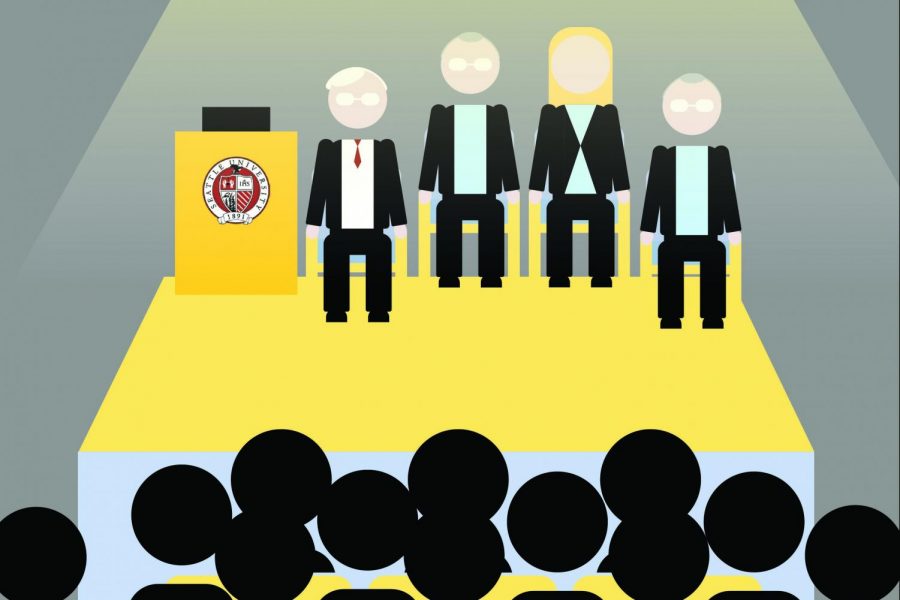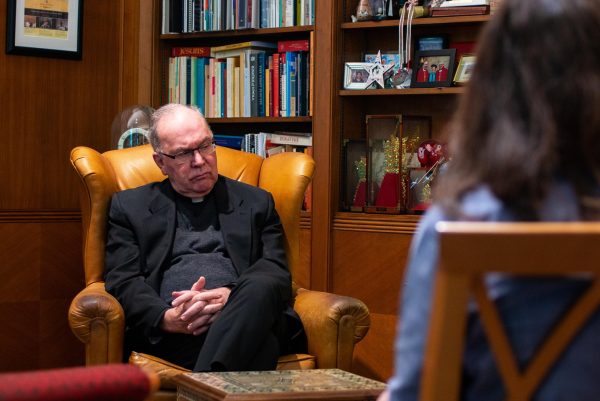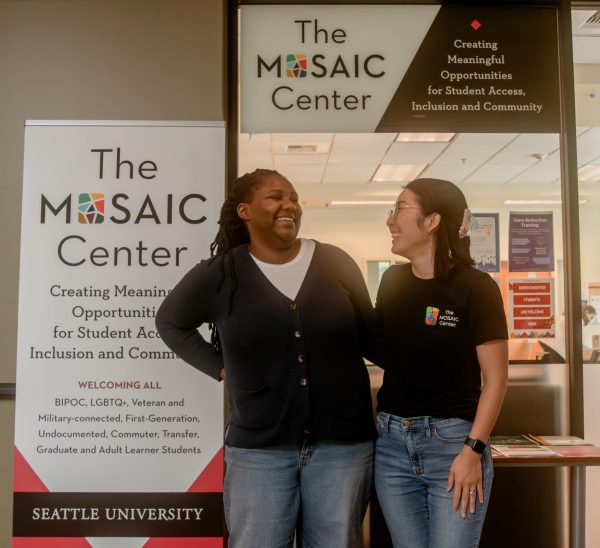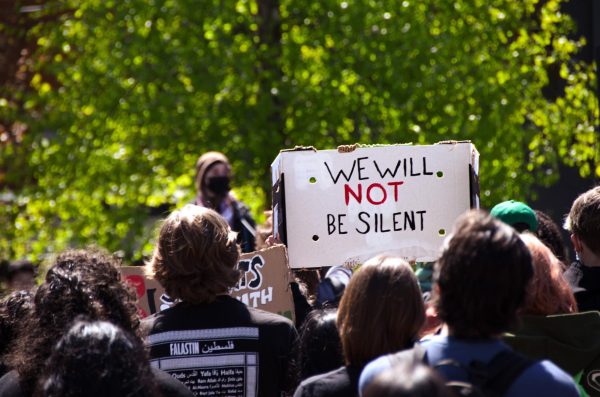Faculty and Staff Share Concerns Regarding University’s Handling of Budget Cuts
For the last three years Seattle University has been operating at a financial deficit, prompting a university wide review of all programs—academic and non-academic—for potential budget cuts.
At this time, no decisions regarding specific budget cuts have been made, but all programs must submit proposals for their own departmental budget cuts by Friday, Feb. 21.
The Forum
Faculty and staff filled Pigott Auditorium on Feb. 18 for the Provost’s Open Forum/Listening Session that was called specifically to address concerns over the impending budget cuts.
At the forum, Seattle U Chief Financial Officer Wilson Garone said the deficit for the 2020 fiscal year currently stands at $3.8 million. The deficits in the 2018 and 2019 fiscal years were $2.9 and $2.3 million, respectively. Provost Shane Martin said at the forum that though most other higher education institutions in the U.S. are experiencing similar financial strain, Seattle U has to face its “financial reality” and quickly course correct.
Some faculty and staff at the forum expressed concern with how the administration plans to remedy issues of decreased enrollment and student retention. These numbers are closely tied to the university’s revenue and a root cause of the university’s current financial state.
Seattle U Provost Shane Martin said that the university lost more students—both undergraduate and graduate—from December to January than they have historically.
Many at Seattle U first became aware of the urgent budget situation after President Fr. Stephen V. Sundborg S.J. sent an email to all university staff and faculty on Jan. 21. In the email, Sundborg addressed the budget shortfall and what he called a “repositioning” of the university’s “financial trajectory” that would take place over the next five years.
Sundborg noted the administration anticipates the largest percentage of budget cuts will come in the 2021 fiscal year. Further, he said they expect “some faculty and staff eliminations,” citing that the majority of the university’s expenses are spent on salaries. At the forum, Seattle U Vice President for Human Resources, Michelle Clements, reiterated this, stating that 75% of the university’s budget is payroll and benefits.
At the open forum, one faculty member asked what kind of support would be given to individuals who lose their jobs as a result of budget cuts.
“Informing people that they’re not going to have a job in April for a cycle that begins in September is not a just way to make transitions and it’s not a way to support those individuals,” the faculty member said. “Because if we’re not [supporting them], then I don’t think we’re living up to our values.”
In response, Clements expressed that these decisions are never easy, but also reiterated that no final decisions regarding any cuts have been “approved or reviewed” by any of the four administration officials present at the event nor by Sundborg. In addition to Clements, Martin, and Garone, Executive Vice President Tim Leary also spoke at the forum.
Martin addressed the scenario the faculty member brought up, saying that in terms of full-time faculty members, something like that would not be a reality.
“That is not in line with our faculty handbook and it’s not how we’re going to proceed,” Martin said.
Jasmine Mahmoud, assistant professor in the Arts Leadership program, said while she appreciates that Seattle U is mission driven, she believes that the university does not do a good enough job of telling its story to bring students in or to make them want to stay at Seattle U. She cited the university faculty pages, course catalogue and master calendar as easy opportunities for the university to share more of its character and intrigue potential students.
Another forum audience member raised concerns as they saw three key common struggles which are barriers to student retention at Seattle U: financial, mental health and academic. They said that on-campus resources which would support students in these struggles, such as the Student Health Center or the Writing Center, are currently underfunded, and they worried that further cuts to these services would only make student retention—and therefore the university’s financial situation—worse.
In response, Martin admitted that the university needs to do a better job of giving early warning and communication regarding students who may be leaving due to these reasons. He said that oftentimes a small change, like a little more financial aid, can help incentivize a student to stay at Seattle U. While first-year student retention has increased in the past year, Martin said that the university saw losses in retention of juniors and seniors, an issue he says the administration is looking into.
Miscommunications about students leaving Seattle U come because the university is highly compartmentalized, according to Martin. He said that there is not much communication between programs which could otherwise aid each other to inform that a student is about to leave. He cited the example that housing may know a student is planning to leave and could inform advisors.
At the forum, Mahmoud additionally challenged the administration to make a “solidarity plan” with their own faculty. Mahmoud said that because faculty and staff are anticipated to take the brunt of the cuts, whether it be through larger class sizes or not being rehired, Mahmoud said that the university’s current financial situation is an opportunity for upper administration to also make their own sacrifices—namely a cut in pay—as they have the highest salaries on campus.
Biology Department Chair, Lindsay Whitlow, echoed Mahmoud’s sentiments in a separate interview with The Spectator. He said that faculty will be making serious sacrifices due to these cuts, as the number of sections offered will have to decrease while the number of students in each section increases. Whitlow said that because the data on salaries is not shared with faculty or staff, it is not entirely clear how drastic the cuts will be among faculty, staff and administration.
“Is that same sort of consideration and calculation being done in the upper administration within the offices of the President, Vice President cabinet? How seriously are the cuts being approached there?” he said. “We just don’t know.”
In an interview with The Spectator, Garone said that all programs and offices, including his own office all the way to the Office of the President are in the scope of the review. He did note that communication about this situation more broadly has not been entirely clear.
“In fairness, our communication has been more reactive and we have an opportunity to be more proactive in the way we communicate,” Garone said. “I think we need to do better in communication. I think we’re taking that seriously.”
According to tax documents filed by the university, which require the university to report its highest earners, between 2012 and 2016 the faculty raise pool increased between 2% and 3% each year. Seattle U’s first highest-earner during all these years was Sundborg. His salary went up 40.22% overall from $319,500 in 2012 to $448,000 in 2016. According to a Seattle Times article published in December of 2011, Sundborg donates most of his salary to the Society of Jesus. In exchange for this, Sundborg lives on campus and has his living expenses covered and receives a $1,000 stipend each quarter.
The second highest-earner at Seattle U during this time was former Provost Isiaah Crawford who received an overall salary increase of 35% over the years. In 2012 Crawford took home $229,728 and in 2016, his final year at Seattle U, he earned $310,346.
Garone said they are not expecting the top earners’ salaries to continue to increase beyond those of faculty.
“Again, we don’t have anything finalized,” Garone said. “I mean, discussions are happening, but there is no discussion whatsoever at this point where administration…would have the salary increase higher than faculty.”
The Process
In an interview with The Spectator, Garone said that all academic programs at Seattle U will submit their individual budget cut proposals to Provost Shane Martin for review. Non-academic programs submit their proposals directly to Garone himself or to Leary.
“These three people manage 100% of expenses in the university,” Garone said. “The process is the same and the timeline is the same.”
These proposals will then move on to the budget advisory group, which Garone said has representation “from colleges, from academic assembly, and from staff.” This group reviews the proposals and makes recommendations to the university Cabinet—the group of administrators at Seattle U.
The Cabinet reviews this proposal and either moves to approve or reject it before they send their recommendations off for final approval by the Board of Trustees on April 30. Only after the Board of Trustees approve it are any decisions final; in all prior stages they are still just recommendations.
The Colleges
Regarding impacts to his own department, Whitlow said that the College of Science and Engineering (CSE) has decided that they will not be cutting any full-time faculty down to part-time as a result of the financial restructuring. Part-time faculty in that college, however, are still at risk of not being rehired in the 2021 fiscal year.
Whitlow said that a full-time faculty member, who can more often engage with students brings a huge educational value to the university even though they’re more expensive to employ than part time faculty—as part-time faculty do not require extra pay for benefits.
The Math Department is a relatively small program that provides a large amount of service courses to other programs in the CSE, and Dean Dylan Helliwell said that these service courses help to protect the department a bit. Though the program will still be under review, it is growing and Helliwell said that the Math department has been “invited to take a smaller cut than other parts of the university.”
Similarly to the CSE, in the Albers School of Business and Economics, Dean Joseph Phillips said that he has communicated with his staff and faculty that no one will be losing their jobs. He said that instead the faculty salary pool for the college will decrease. This means that while people will not be let go, as others retire or leave the university, their roles may not be filled again.
He says he does not, however, anticipate that these changes will affect the college’s ability to maintain their program or provide key classes needed by students in the college.
Phillips also said that a new market, with increased competition and decreased affordability of higher education, can shift public interests and therefore how a university should move forward. For example, in his school he has seen a decreased interest in the Masters in Business Administration program and thus may focus on more specialized degrees. This shift in the market means that universities must also change how they market to potential students, according to Phillips.
Prior to these most recent budget conversations, two small schools on campus were already feeling the pressures of decreased enrollment numbers.
The School of Theology and Ministry (STM) formed a working group and created a proposal for how the school should move forward based on the cost and sustainability of the program. According to Dean Mark Markuly this group additionally considered the non-monetary values that the school provides the university as a religious school on the Jesuit Seattle U campus. The STM has presented their review, but does not have any final decisions as of yet. It is not yet entirely clear how this new round of budget cuts will impact the school.
One area in which Markuly expects his school to be impacted is in their budget and ability to perform outreach and community service. However, he hopes that this will not impact student recruitment or retention.
Markuly said that similar to how religious institutions and practice have shifted form, all institutions—including higher education—have their place and time. He echoed the sentiment that the university’s financial struggles may be a part of a larger national trend.
“One of the things that is hard for people to get their head around is historically, you go through cultural transformation moments in which the institutions of one era no longer really fit where people are at, and are no longer responding to whatever they feel they need,” Markuly said. “And so you go into a period where some of those institutions can kind of change, some of them go away, new ones are created. And it’s not just higher ed that’s in this moment.”
Like Phillips, New and Continuing Studies (NCS) Dean Richard Fehrenbacher cited a changing national job market and landscape as reasons for a need to shift how the university delivers education. Fehrenbacher said that in many ways higher education is shifting away from just traditional students. Instead, there are new demands as people change career paths more often and thus and thus require additional certificates or skills training. He sees this national change as an opportunity for the university to grow or shift its services.
The School of NCS has submitted its own review of the program for evaluation by the Program Review Committee, and like the STM working group, this is seperate from the current budget cut proposals. Regardless of the results of this review, Fehrenbacher said that he has trust and hope in Clements and the HR team’s dedication to “provide the softest landing possible” for people who do lose their job in this process.
“You get attached to people here,” he said. “And the fact that anybody might have to leave is always something that’s painful.”
Frances Divinagracia and Josh Merchant contributed reporting to this article.












christian
Feb 23, 2020 at 8:56 pm
why doesn’t father steve stop giving his money to the society of jesus and give it to his staff lol